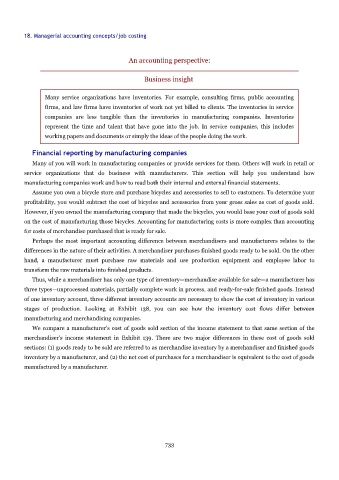Page 732 - Accounting Principles (A Business Perspective)
P. 732
18. Managerial accounting concepts/job costing
An accounting perspective:
Business insight
Many service organizations have inventories. For example, consulting firms, public accounting
firms, and law firms have inventories of work not yet billed to clients. The inventories in service
companies are less tangible than the inventories in manufacturing companies. Inventories
represent the time and talent that have gone into the job. In service companies, this includes
working papers and documents or simply the ideas of the people doing the work.
Financial reporting by manufacturing companies
Many of you will work in manufacturing companies or provide services for them. Others will work in retail or
service organizations that do business with manufacturers. This section will help you understand how
manufacturing companies work and how to read both their internal and external financial statements.
Assume you own a bicycle store and purchase bicycles and accessories to sell to customers. To determine your
profitability, you would subtract the cost of bicycles and accessories from your gross sales as cost of goods sold.
However, if you owned the manufacturing company that made the bicycles, you would base your cost of goods sold
on the cost of manufacturing those bicycles. Accounting for manufacturing costs is more complex than accounting
for costs of merchandise purchased that is ready for sale.
Perhaps the most important accounting difference between merchandisers and manufacturers relates to the
differences in the nature of their activities. A merchandiser purchases finished goods ready to be sold. On the other
hand, a manufacturer must purchase raw materials and use production equipment and employee labor to
transform the raw materials into finished products.
Thus, while a merchandiser has only one type of inventory—merchandise available for sale—a manufacturer has
three types—unprocessed materials, partially complete work in process, and ready-for-sale finished goods. Instead
of one inventory account, three different inventory accounts are necessary to show the cost of inventory in various
stages of production. Looking at Exhibit 138, you can see how the inventory cost flows differ between
manufacturing and merchandising companies.
We compare a manufacturer's cost of goods sold section of the income statement to that same section of the
merchandiser's income statement in Exhibit 139. There are two major differences in these cost of goods sold
sections: (1) goods ready to be sold are referred to as merchandise inventory by a merchandiser and finished goods
inventory by a manufacturer, and (2) the net cost of purchases for a merchandiser is equivalent to the cost of goods
manufactured by a manufacturer.
733

